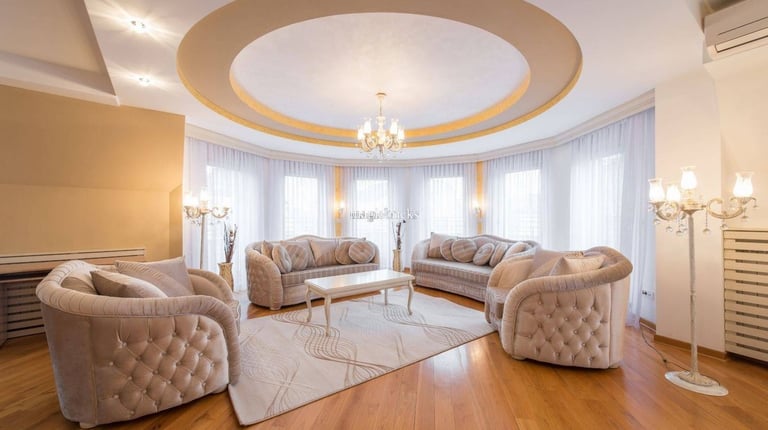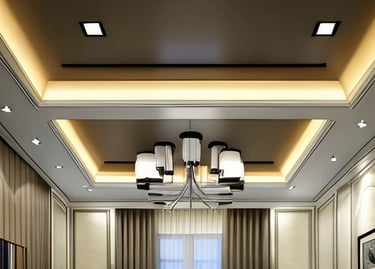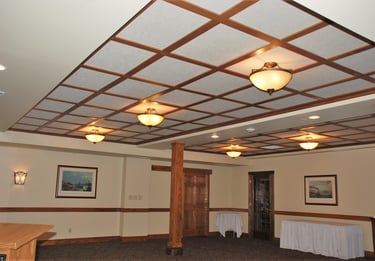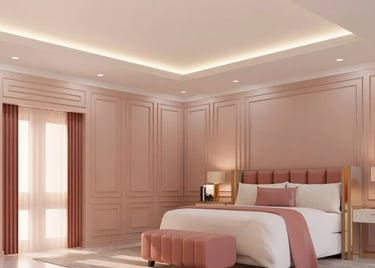Elevate Your Space: A Comprehensive Guide to False Ceilings for Modern Interiors
Discover the magic of false ceilings—where design meets innovation, and every glance upward unveils a canvas of possibilities.
Sakina Baxa
9/12/20246 min read


False Ceiling: Enhancing Spaces with Elegance
A false ceiling, also known as a drop ceiling or suspended ceiling, is a secondary ceiling installed below the main structural ceiling of a room. It serves both functional and aesthetic purposes, adding depth, style, and insulation while concealing wires, ducts, and pipes. False ceilings come in various designs and materials, offering a wide range of options to elevate the look and feel of interior spaces.
Types of False Ceiling by Design:
1) Peripheral false ceiling:
Peripheral false ceilings are a unique design concept that involves extending the false ceiling beyond the central area of a room to cover the peripheral or outer edges. This design approach adds depth, dimension, and visual interest to the ceiling, creating a seamless transition between the walls and the ceiling.
By extending the false ceiling to the periphery of the room, it creates a sense of continuity and enhances the overall aesthetics of the space. This design technique is particularly effective in rooms with irregular shapes or high ceilings, as it helps to balance the proportions and create a more cohesive look.
Peripheral false ceilings can be customized to suit different design styles and preferences. They can feature recessed lighting, decorative elements, or integrate architectural details to complement the overall interior design theme. Additionally, incorporating materials such as wood, metal, or gypsum can further enhance the visual appeal and texture of the peripheral false ceiling.
Overall, peripheral false ceilings offer a creative and versatile way to add sophistication, character, and architectural interest to a room, making it a standout feature that elevates the overall design aesthetic.
2) Island false ceiling or double layer false ceiling:
An island false ceiling is a design concept where a portion of the ceiling is lowered or highlighted to create a distinct island-like structure within the overall ceiling space. This design technique is often used to define specific areas within a room, such as dining areas, kitchen islands, or seating nooks, by visually separating them from the rest of the space.
Island false ceilings can be created in various shapes and sizes, such as rectangular, square, circular, or irregular shapes, depending on the room's layout and design requirements. They can be used to add architectural interest, highlight focal points, or create a sense of intimacy within a larger room.
This design feature is often enhanced with lighting elements, such as pendant lights or recessed lighting, to accentuate the island structure and create a cozy ambiance. Additionally, island false ceilings can be customized with different materials, textures, and finishes to complement the overall interior design theme and add a touch of sophistication to the space.
3) Geometric false ceiling:
Geometric false ceilings are a modern and stylish design concept that involves creating geometric patterns, shapes, or forms on the ceiling surface. This design approach adds visual interest, depth, and a contemporary flair to the space, transforming a plain ceiling into a focal point of the room.
Geometric false ceilings can feature a variety of shapes, including squares, rectangles, triangles, circles, hexagons, or abstract patterns, depending on the desired aesthetic and design theme. These geometric elements can be achieved through different techniques, such as using different materials, colors, lighting effects, or raised/lowered sections of the ceiling.
This design concept allows for endless creativity and customization, allowing designers to play with symmetry, scale, and proportion to create unique and visually striking ceiling designs. Geometric false ceilings are particularly popular in modern and minimalist interior designs, adding a touch of sophistication and architectural interest to the space.
By incorporating geometric elements into the false ceiling design, homeowners and designers can create a dynamic and eye-catching feature that enhances the overall aesthetics of the room, making it a statement piece that elevates the interior design to a whole new level.
4) Coffered false ceiling:
A coffered false ceiling is a classic and elegant ceiling design that features a series of recessed panels or sunken squares, creating a grid-like pattern on the ceiling surface. This design technique adds depth, texture, and architectural interest to the ceiling, giving it a luxurious and sophisticated look.
Coffered ceilings are characterized by a series of intersecting beams that divide the ceiling into multiple square or rectangular sections, forming a coffered grid pattern. These recessed panels can be plain, decorated with molding or trim, or even painted in contrasting colors to create a dramatic visual impact.
Coffered false ceilings are often associated with traditional or formal interior designs, adding a sense of grandeur and elegance to the space. They can be customized in various sizes, depths, and configurations to suit different room sizes and architectural styles.
One of the key benefits of coffered ceilings is their ability to enhance acoustics by absorbing sound and reducing echo in the room. Additionally, coffered ceilings can incorporate lighting fixtures, such as recessed lights or chandeliers, within the recessed panels, adding both functional and aesthetic value to the space.
5) Grid false ceiling:
A grid false ceiling, also known as a modular grid ceiling, is a type of false ceiling design that features a grid-like structure of interlocking metal or PVC panels suspended from the main structural ceiling. This design creates a series of square or rectangular openings, forming a grid pattern on the ceiling surface.
Grid false ceilings are popular in commercial spaces, offices, and educational institutions due to their flexibility, ease of installation, and accessibility for maintenance. These ceilings allow for easy integration of lighting fixtures, air vents, and other ceiling-mounted elements within the grid modules.
The grid structure of these false ceilings provides a clean and organized look to the ceiling while allowing for efficient installation and replacement of ceiling tiles as needed. Grid false ceilings can be customized with different panel sizes, finishes, and colors to suit the overall design scheme of the space.
Overall, grid false ceilings offer a practical and versatile ceiling solution that combines functionality with a modern aesthetic, making them a popular choice for a wide range of interior spaces.
6) Curved-down ceiling designs:
A curved false ceiling design is a modern and visually striking approach to ceiling architecture that involves incorporating curved or arched elements into the ceiling structure. This design technique adds a sense of fluidity, movement, and sophistication to the space, creating a dynamic focal point that sets the room apart.
Curved false ceilings can be constructed using a variety of materials, such as gypsum boards, metal panels, wood, or even flexible materials that can be molded or shaped into curved forms. These curved elements can range from gentle curves to more dramatic arches, depending on the desired aesthetic and design intent.
Curved false ceilings are popular in contemporary interior design, adding a touch of architectural interest and elegance to residential spaces, hotels, restaurants, and commercial establishments. They can be customized to complement the overall style and theme of the room, making a bold statement while enhancing the visual appeal of the ceiling.
7) Plain False Ceiling:
A plain false ceiling, also known as a flat or simple false ceiling, is a straightforward ceiling design that features a smooth and uniform surface without any intricate or decorative elements. This type of ceiling design is characterized by its clean lines, minimalistic aesthetic, and understated elegance.
Plain false ceilings are typically constructed using gypsum boards, plaster of Paris (POP), or ceiling tiles that create a seamless and flat finish across the ceiling surface. This design approach is versatile and timeless, suitable for a wide range of interior styles and preferences.
While plain false ceilings may lack elaborate detailing or ornamentation, they offer a clean and polished look that can help in creating a sense of spaciousness, brightness, and simplicity in the room. These ceilings provide a neutral backdrop that can complement various decor styles and color schemes.
One of the advantages of plain false ceilings is their versatility and compatibility with different lighting options, such as recessed lights, pendant fixtures, or track lighting, allowing for customizable illumination in the room. Additionally, plain ceilings are easy to maintain and can be cost-effective compared to more elaborate ceiling designs.










